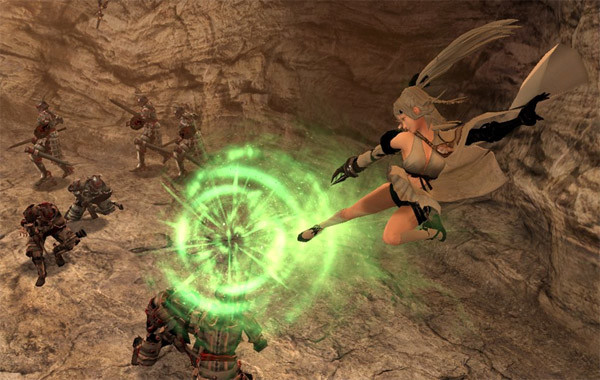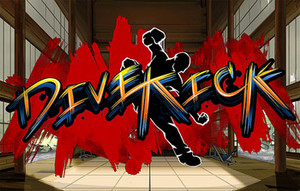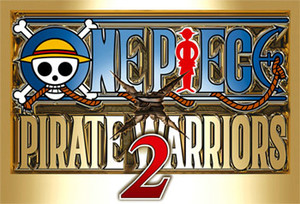The X Button
Duck Down
by Todd Ciolek,

Capcom's Gaist Crusher is a conventional attempt at spawning a new toy-and-game franchise for kids. It stars a bunch of heroes who wear Saint Seiya armor and battle giant robo-monsters, all of them ready for toy treatments. The game also joins together plaything and game with the Gaiphon Cover for the 3DS. It lets kids attach transforming Gai Metal figures (once they've bought them) to the system and unlock certain features in the Gaist Crusher game. I'd probably think that was pretty neat if I were eight years old and not yet crazed by Skylanders and Disney Infinity.

I am not interested in collecting Gaist Crusher games and assorted merchandise, but I really hope the whole franchise does well in Japan (and perhaps makes it to the U.S.). Why? Because the game was developed by Treasure, makers of Gunstar Heroes and Bangai-O and Sin and Punishment and a bevy of other neat action titles. Treasure is dishearteningly silent these days, and even their recent output consisted of sequels and Xbox Live remakes. I'd very much like to see an all-new Treasure game, one not bound to any existing property. I'm sure a dose of Gaist Crusher money would help out there.
NEWS
SURPRISE LOCALIZATION THEATER PRESENTS: AQUAPAZZA AND CHAOS CODE
There was time, during the '90s heyday of fighting games, when just about every new piece of the genre stood a fair chance at coming to North America. We missed out on Battle Tycoon and Critical Blow and some others, but the odds were that if a fighting game existed, someone was interested in localizing it. That changed as fighting games grew less dominant later in the decade, and yet it seems as though the modern era, with its digital downloads and devil-may-care attitude, could return to those days of yore. Consider Aquapazza and Chaos Code, both of which will be out later this year for the PlayStation 3.

Aquapazza brings together numerous anime and visual-novel properties, none of which has much pull in North America. The game's 13 playable fighters and equal number of assistants come from Utawarerumono, the To Heart series, Kizuato, Routes, Tears to Tiara, Comic Party, and White Album. Yet one needs little knowledge of these properties when the characters are all pounding each other in a 2-D fighting game, and Atlus USA clearly knows this. That's why Aquapazza will arrive here for thirty bucks, with Japanese voiceovers and all.

Chaos Code has no major tie-ins to anime or dating sims, yet it nonetheless crams in both predictable stereotypes and less common ones. Among the assortments of dashing, glowing-fisted men and curvaceous women are a chef, cat-eared twins who fight as one, and a cosplayer who switches outfits mid-combo. Developed by FK Digital, the game allows player to switch between a speed-oriented “run” style and a slower, strategy-oriented pace. As a digital-only release, Chaos Code will cost only twelve bucks when it arrives here.
LET'S LOOK AT AND POSSIBLY MIS-NAME DRAKENGARD 3
Yes, we're still calling this game Drakengard 3. Perhaps we should refer to it by its Japanese title of Drag-On Dragoon 3, since Square hasn't announced it for a U.S. release. Dubbing it Drakengard 3 is wishful thinking on the part of the gaming press and fans of director Yoko Taro, who most recently gave us the rather daring Nier.

Drakengard 3 returns to the less experimental ground of Taro's prior games. The original Drakengard was unintentionally awful in gameplay and intentionally awful in its storyline, while the sequel improved the gameplay just a bit. Developed for the PlayStation 3, Drakengard 3 apparently unfolds before either game and has the same principle: a warrior roams medieval-fantasy battlefields thick with foes and occasionally jumps aboard a dragon to wreak aerial destruction. The warrior this time around is Zero, an “utautai” goddess who wanders around killing and/or having sex with whosoever she pleases, including the four men who serve as her Apostles. Her violent habits may not sit too well with her dragon, a placid sort named Mikhail.

Square recently delayed Drakengard 3 to a December release in Japan, reportedly in the hopes of increasing the game's quality. It's not clear how well the game might turn out; Taro's working with middle-grade developer Acquire, and footage of the game looks a bit primitive. At the very least, the actual combat may improve on past Drakengards, as Zero can swap weapons in the middle of attacking, dive-kick enemies, and team up with her Apostles.

The storyline finds Zero facing off against her similarly named sisters, most of whom have their own countries and predilections. The scholarly and reserved One (at the center) has a strained, seemingly nonviolent relationship with her sister, but the others appear to be antagonists from whom Zero must rescue her Apostles. Blonde-haired Five is a woman of dangerous appetites, blue-haired Two is an upbeat social butterfly, purplish-haired Three is laid-back and obsessed with creepy dolls, and brown-haired Four has pitiably low self-esteem. Then there's Zero, with a flower growing from her eye.

Will Drakengard 3 also maintain the series tradition of overdosing on things dark and repellent? Taro has said that the game won't be like Drakengard (which is good) or Nier (which is troubling), but Square's released several lurid short stories that introduce Zero and her sisters. One of them describes Zero murdering dozens after she's forced into prostitution by her own mother, and some report that a currently running tie-in Drakengard manga is even nastier. Some of that might bleed over into the game itself, but perhaps the whole Grimsex Murderdark buildup is a big lie and that Zero and her sisters are squabbling over who's driving who to the mall. I would play a game about that.
DOWNLOAD REVIEWS: AUGUST
DIVEKICK Developer: Iron Galaxy
Developer: Iron Galaxy Publisher: Iron Galaxy Platform: PlayStation 3, PS Vita, PC (Steam) MSRP: $9.99 Divekick is essentially what your grandparents and your disinterested friends think all fighting games are: two stereotypes kicking at each other until one falls over. Divekick keeps that simple philosophy at its heart, with only two buttons controlling a character's movement on the screen. Dive normally makes you jump, kick makes you attack in the air or skip backwards on the ground, and tapping both together brings out a special move. Yet the divekick counts most, and most matchups play out like the last moments of a heated bout, when both players are down to a sliver of health and the next hit decides all. This simple idea turns every match into a short, intense game of fake-outs and perfect timing, and so it's appealing to both the devoted fighter geek and the casual player. That's half of the joke. The other half of the joke lies in the manifold in-jokes of the Divekick's characters and power-ups. There's a knock at Capcom's gem-based power-ups for Street Fighter X Tekken. There's a character named The Baz, inspired by a rejected design from the original Street Fighter. There are Divekickers based on fighting-game celebrities Seth Killian and MarkMan. References alone aren't comedy, of course, but there's also a series of pre-fight aphorisms by “Uncle Sensei,” and he's often funny beyond the realm of kicky-punch games. Is Divekick just a joke, graffiti on the wall of a better fighting game's backalley stage? Well, yes. But more than fifty percent of that joke is amusing, the sort of attraction that's both low-effort and highly competitive. It may go over better if the room's full of fighting-game nerds, of course.
|
DUCKTALES REMASTERED Developer: Wayforward
Developer: Wayforward Publisher: Capcom Platform: Xbox Live/PlayStation Network/Wii U/PC (Steam) MSRP: $14.99 DuckTales Remastered doesn't stop at remaking Capcom's beloved NES game. No, Wayforward also summons the Disney cartoon that inspired it. On top of the revamped levels and brightly animated sprites, the game evokes the TV series with its numerous story sequences, bridging levels with a tale of Scrooge McDuck racing the Beagle Boys and his rival Flintheart Glomgold in a search for legendary treasures. It's on par with a typical episode of DuckTales, though not a great one, and Disney provides as many of the original show's voice actors as possible. It's both heartwarming and sobering to hear Alan Young, now 93, play Scrooge once again. I nearly expected an ending where the wealthy McDuck describes a dream he had about his father and realizes that this is no country for old Disney icons. Beyond the frequent evocations of the DuckTales cartoon, WayForward's remake follows the NES version closely. Scrooge explores the Himalayas, the Moon, and other landscapes with little more than his cane, which rather ingeniously doubles as a pogo stick. Bounding all across stages is just as enjoyable here as it is in the NES original, and WayForward's knack for excellent 2-D animation comes through in every character. It's less apparent in the backgrounds, which are low-detail 3-D scenery by comparison. At least the soundtrack is unadulterated as it remixes the NES tracks into some amazing numbers. The only failing is that Wayforward didn't expand the game enough. Each level builds a little on its NES ancestor, adding some new objectives in the form of ancient coins or pieces of Gizmo Duck's suit, but the stages aren't all that much longer. This makes it a shade more irritating when the game breaks into conversations every minute or so, intent on showing off the voice cast and detailing some minor point of the storyline. Wayforward's additions to the game are sharp and entirely faithful to the hard-won victories that NES games were in your childhood; boss encounters are much more demanding, and a final stage pushes everything to the edge between frustration and triumph. It's a shame that there isn't more of it to balance out the frequent cutscenes. Remastered really is an average DuckTales outing; it's not all it could have been, but there's plenty of fun to be had.
|
GONE HOME  Developer: The Fullbright Company
Developer: The Fullbright Company Publisher: The Fullbright Company Platform: PC (Steam) MSRP: $19.99 Gone Home is best approached without any introduction. All you need know is that you're Katie, a young woman who returns from a European getaway to her parents' new house. They're not home. Neither is Katie's teenage sister Sam, though she left a somewhat troubling note on the front door. The player controls Katie from a first-person view as she wanders the house, piecing together just where everyone went. Fortunately, hers is a family that tends to leave plenty of relevant information out in the open, whether it's a rejection letter or a photo of someone's first love. The obvious item-hunting aside, Gone Home builds a remarkably plausible vision of a suburban home in the mid-1990s, down to the TV schedules, the answering machines, and the piles of hand-labeled VHS tapes. Sam's diary recordings also play as Katie explores the house, and in time just about every question is answered. The underlying mysteries of Gone Home are familiar; you've encountered this sort of story in numerous books, films, and, dare I even invoke the comparison, Lifetime Original Movies. That's not important. It's the presentation that gives Gone Home its rare impact. Business letters or crumpled classroom notes unfold into broad portraits, while leavings of teenage punk rebellion entwine with a deeper awakening. Once everything unfolds and builds to an ending most will see coming and few will shrug off, it hits a good deal harder than the typical video-game arc about slaughtering cyberpunk terrorists or toppling alien-backed dictators. It's a tale told through gameplay, and there's something genuine and personal to find. In a year stacked with both blockbuster show-offs and quieter little gems, Gone Home might be the game that matters most. |
NEXT WEEK'S RELEASES
ONE PIECE: PIRATE WARRIORS 2  Developer: Omega Force
Developer: Omega Force Publisher: Namco Bandai Games Platform: PlayStation 3 (PSN only) Release Date: September 3 MSRP: TBA The original One Piece: Pirate Warriors didn't mess with formulas. It stuck to the open stages, swarming enemies, and predictable pace of a typical Dynasty Warriors game, and it followed much the same path as the One Piece storyline that's sold so many manga volumes and anime advertising slots. Pirate Warriors 2 likely doesn't break with gameplay traditions. Battles remain massive brouhahas where a familiar One Piece character belts around scores of marines, pirates, or monsters until a tougher (and usually larger) boss crashes the scene and provides a bit more of a challenge. The changes this time around lies in the smaller methods to this madness. The original game called in crew members for occasional help, but Pirate Warriors 2 lets the player switch out a character and control a pirate partner in the midst of combat. The game's Haki energy system also allows characters to choose between different attack enhancements. Nearly thirty playable characters are on hand, ranging from the usual Straw Hat Pirates to the rarely playable Perona and her ghost sidekicks. This being One Piece, they're happy ghosts. However, Pirate Warriors 2 is independent in its storyline. While it hits familiar sights and story elements from the manga and anime, the game differs a bit in the details as it sends Monkey D. Luffy and the rest of the Straw Hat Pirates into both battles and alliances with the Whitebeard Pirates and other rivals. It's a bit like one of those single-shot One Piece movies that the central storyline never acknowledges. I doubt we'll see some dark mockery in the style of Mamoru Hosoda's Baron Omatsuri and the Secret Island, but you never know.
|
Next week is something of a lull after this one's city-sacking barbarian horde of games, but you'll see Dead or Alive 5 Ultimate. It expands last year's fighter with new modes, a Power Launcher move, and five more characters: Momiji and Rachel from Ninja Gaiden, Jacky Bryant from Virtua Fighter, and Ein and Leon from...well, previous Dead or Alive titles.
discuss this in the forum (11 posts) |
this article has been modified since it was originally posted; see change history